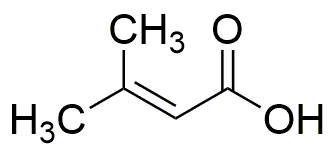3-Methylcrotonic acid is widely utilized in research focused on:
- Organic Synthesis: This compound serves as a building block in the synthesis of various organic molecules, particularly in the production of pharmaceuticals and agrochemicals, enabling the development of new drugs and crop protection agents.
- Biochemical Research: It is used in metabolic studies to understand the role of branched-chain fatty acids in biological systems, aiding researchers in exploring metabolic pathways and disorders.
- Polymer Chemistry: The compound is employed in the production of specialty polymers, enhancing properties such as flexibility and thermal stability, which are crucial for applications in coatings and adhesives.
- Flavor and Fragrance Industry: 3-Methylcrotonic acid is utilized in the formulation of flavoring agents and fragrances, providing unique scent profiles that are appealing in consumer products.
- Analytical Chemistry: It is used as a standard in chromatography for the analysis of various organic compounds, ensuring accurate identification and quantification in complex mixtures.
Informations générales
Propriétés
Sécurité et réglementation
Applications
3-Methylcrotonic acid is widely utilized in research focused on:
- Organic Synthesis: This compound serves as a building block in the synthesis of various organic molecules, particularly in the production of pharmaceuticals and agrochemicals, enabling the development of new drugs and crop protection agents.
- Biochemical Research: It is used in metabolic studies to understand the role of branched-chain fatty acids in biological systems, aiding researchers in exploring metabolic pathways and disorders.
- Polymer Chemistry: The compound is employed in the production of specialty polymers, enhancing properties such as flexibility and thermal stability, which are crucial for applications in coatings and adhesives.
- Flavor and Fragrance Industry: 3-Methylcrotonic acid is utilized in the formulation of flavoring agents and fragrances, providing unique scent profiles that are appealing in consumer products.
- Analytical Chemistry: It is used as a standard in chromatography for the analysis of various organic compounds, ensuring accurate identification and quantification in complex mixtures.
Documents
Fiches de données de sécurité (FDS)
La FDS fournit des informations de sécurité complètes sur la manipulation, le stockage et l’élimination du produit.
Spécifications du produit (PS)
Le PS fournit une description complète des propriétés du produit, notamment sa composition chimique, son état physique, sa pureté et les exigences de stockage. Il détaille également les plages de qualité acceptables et les applications prévues du produit.
Certificats d'analyse (COA)
Recherchez des certificats d'analyse (COA) en saisissant le numéro de lot du produit. Les numéros de lot et de lot se trouvent sur l'étiquette d'un produit, après les mots « Lot » ou « Lot de fabrication ».
Numéro de catalogue
Numéro de lot/série
Certificats d'origine (COO)
Ce certificat d'exploitation confirme le pays dans lequel le produit a été fabriqué, et détaille également les matériaux et composants utilisés et s'il est issu de sources naturelles, synthétiques ou autres sources spécifiques. Ce certificat peut être requis pour les douanes, le commerce et la conformité réglementaire.
Numéro de catalogue
Numéro de lot/série
Fiches de données de sécurité (FDS)
La FDS fournit des informations de sécurité complètes sur la manipulation, le stockage et l’élimination du produit.
DownloadSpécifications du produit (PS)
Le PS fournit une description complète des propriétés du produit, notamment sa composition chimique, son état physique, sa pureté et les exigences de stockage. Il détaille également les plages de qualité acceptables et les applications prévues du produit.
DownloadCertificats d'analyse (COA)
Recherchez des certificats d'analyse (COA) en saisissant le numéro de lot du produit. Les numéros de lot et de lot se trouvent sur l'étiquette d'un produit, après les mots « Lot » ou « Lot de fabrication ».
Numéro de catalogue
Numéro de lot/série
Certificats d'origine (COO)
Ce certificat d'exploitation confirme le pays dans lequel le produit a été fabriqué, et détaille également les matériaux et composants utilisés et s'il est issu de sources naturelles, synthétiques ou autres sources spécifiques. Ce certificat peut être requis pour les douanes, le commerce et la conformité réglementaire.


